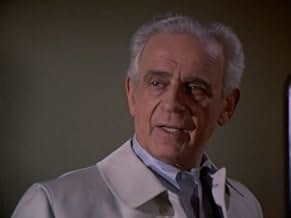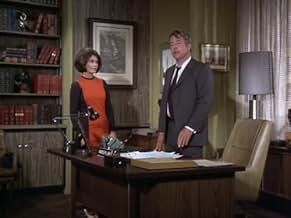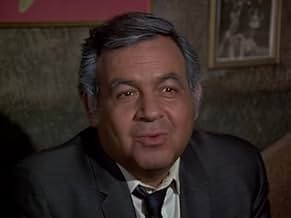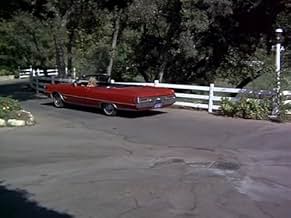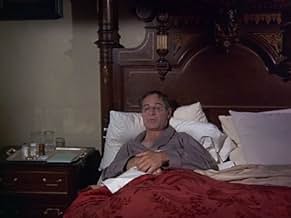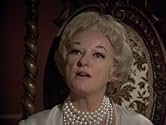Rod Serling presenta cuentos de terror ilustrados en varios cuadros.Rod Serling presenta cuentos de terror ilustrados en varios cuadros.Rod Serling presenta cuentos de terror ilustrados en varios cuadros.
- Nominado a 2 premios Primetime Emmy
- 2 premios ganados y 4 nominaciones en total
Explorar episodios
Opiniones destacadas
10sskelton
Often lost in the shadow of Rod Serling's first series, "The Twilight Zone," "Night Gallery" was a fascinating experiment in the anthology format. Instead of one story per episode, the hour was splintered into two, three, or four different stories of varying length. Some were quite brief, lasting no more than a minute; others lasted over 40 minutes. The quality often varied, too. A few of the little vignettes were quite bad. Some stories were quite good. And on more than a few occasions, this little mini-film festival on Wednesday nights produced segments that were as good as anything else on TV at the time. Classic episodes included "They're Tearing Down Tim Riley's Bar," "Pickman's Model" (both nominated for Emmys), "The Caterpillar," "Class of '99," "Green Fingers," "The Messiah on Mott Street," "The Sins of the Fathers," "The Doll," "Cool Air," "Silent Snow, Secret Snow," "A Question of Fear," "The Little Black Bag," and "The Dead Man." Because one of these classics could often be followed or preceded by a story of lesser quality, the series got a reputation for being wildly uneven. It was universally lambasted during its network run by near-sighted critics who were thrown off by its inconsistency, and missed the quality elements: intelligent, stylish writing by Serling and others, top-notch production values (particularly in cinematography and music), and innovative directorial touches. For its syndication run, the series segments were butchered to fit into a half-hour time slot, some losing half their length in the editing, and is a travesty, a mere shadow of its former self. Episodes of a boring ESP potboiler, "The Sixth Sense," were annexed into the syndie package with terrible results. Stick to the uncut version.
I grew up watching this as a really little kid in Brooklyn, my family loved this show and it's probably the reason I still suffer from Night Terrors to this DAY! I was 5 when I saw 1971 episode THE DOLL. (there are 2 different doll episodes, I think the other is from 73 and is called Doll of Death)
Anyhoo, I was SO FREAKED out from watching that 71 The Doll episode that I still remember having horrible nightmares as a kid and I called the Episode The Doll with the Black Eyes. I couldn't sleep in a room with dolls, and I had a new strange raggedy ann type doll my aunt had just bought me, and she had Solid Black Eyes. I loved that doll, but could not sleep with it in my bed or anywhere in my room at night after this episode. I would make my Mom lock it up every night. Seriously!! I Never wanted to re-watch that episode growing up and even as an adult cannot sleep in any room with dolls. I finally re-watched this in 2004, I'm a grown woman and YES, it still CREEPED ME OUT!! It's like this episode gave me PTSD as a kid, and all those feelings of Terror came flooding back. I know, it sounds crazy, but it's TRUE! I haven't watched it since. LOL I'm creeped out just writing this and remembering how terrorized I felt as a child. Rod Serling was Great and I love him to this day, but his show Freaked me out and left my sleep disturbed to this day. But weird thing is I always Loved Horror Movies and can watch The Walking Dead alone at night with no problems, but Don't play the Doll with the Black Eyes for me, cause I don't think I will sleep for days. :o Great old school series with alot of creepy and disturbing episodes. ;D.
I vaguely remember watching this show when I was a small child when it was a regular series. I watched it in syndication when I was an adolescent and have watched it as an adult on the Sci-Fi channel, so I guess that you could say I have had a chance to view Night Gallery from three very different perspectives. Rod Serling was a true genius who was often called television's "first angry man". What I mean is that he wrote scripts for tv that dealt with real social issues and were not meant as fluff entertainment. He wanted to send out a message with the stories that he wrote. Serling wrote such classic screenplays as Requium For A Heavywieght and Patterns. He probably would not have liked it that he was best remembered for The Twilight Zone! Night Gallery was the last series he hosted before his untimely death in 1975. Each episode had about three or four stories. Of course they didn't hit the target with all of them, but they still had a good batting average! Some of the episodes were disturbing and terrifying and some were just meant to be merely humerous. I remember one with Leslie Nielsen as the Phantom of the Opera (keep in mind this was before the Naked Gun and Police Squad when he was a dramatic actor). The girl unmasked him and he unmasked her and found she was as deformed as he was! They had another episode that I clearly remember about a time traveler who was a survivor of the Titanic who was picked up by the Lusitania who was then rescued by the Andrea Doria! The one that I remember the most, the one that chilled me was the one about a boy who could see the future and then described a horrifying vision where the sun would explode (a nova) and would incinerate the earth! The fun part of this show was the high quality of the guest stars that they had everyone from Burgess Meredith to Ozzie and Harriet Nelson to Leonard Nimoy. Gary Collins was Night Gallery's most frequent guest star, he played a parapsychologist named Doctor Rhode's who investigated all kinds of odd cases and his character was so popular that he even got his own series. I always enjoyed every episode that Mister Collins was in. People don't realize this, but the original Night Gallery movie in 1969, the series pilot was one of the first television movies ever made! In fact, one of the directors who did one of the stories was a young man named Steven Spielburg! The story I most remember from the pilot was one with Richard Kiley as a Nazi War Criminal who meets a truly just and horrifying end. A man who put too many Christs on crosses for any God to give him forgiveness! Rod Serling fought in World War II as a paratrooper and was severely wounded. His wife said in an interview that he never stopped having nightmares about the war and many of the stories he wrote for the Twilight Zone and Night Gallery deal with the horrors of war. Rod Serling was a true genius who wrote stories that entertained us and made us think at the same time.
The Night Gallery was Rod Serling introducing tales of terror and irony much like he did for the Twilight Zone. While the TZ dealt more with Sci-Fi, Night Gallery dealt with the macabe. Damn, was it good and scary. The stories that stood out in my mind were the Tune In Dan's Cafe, Green Fingers and They're Aren't Anymore McBanes. Talk about scary. I remember watching the McBanes episode and it scared the daylights out of me and my mother who was watching it with me. The TUne in Dan's Cafe is very haunting. To me this is one of the best anthology shows ever, ranking up there with the Outer Limits(the original) Tales From the Darkside, One Step Beyond, and the great Twilight Zone. I love the fact that the Sci-Fi channel runs Twilight Zone episodes back to back in front of the older Outer Limits episodes. Now if only it would add the Night Gallery all would be perfect in the afternoon. The Night Gallery is classic horror anthologies at their best. Great acting, great stories, scary as hell. Pass the popcorn and get ready for some real chills. way to go Rod Serling another classic show.
There is something that sets Night Gallery apart from all other sci-fi/thriller TV shows. An ethereal element of mystique lurks within every episode that provides for unique entertainment. Narrated by Rod Serling, Night Gallery explores the supernatural from the context of an abstract painting--a different painting each episode. When narrating his previous series, The Twilight Zone, Serling generally manifested an air of superiority to the plot--like he had it in the palm of his hand and could control it. In Night Gallery, however, he relinquishes such control and becomes more a PART of the madness; as if the gallery is controlling HIM (it is also refreshing to finally view him in color). Night Gallery episodes are NOT concluded with a Serling anecdotal summary; instead, a shocking punch is usually delivered that the viewer is left to unravel without assistance.
The directing and editing are top notch. Scenes cascade in a swift and somewhat ambiguous fashion, and camera tricks are cleverly exploited to hold our attention--proving that today's computer graphics are not essential to exact viewer interest. Simple story lines are translated into convoluted journeys of intrigue with music and sound effects akin only to The Exorcist.
Some memorable episodes include Sally Field playing a woman with multiple personalities (this was before she played Cybil, mind you); an ostracized young girl who befriends a seaweed monster; a diner jukebox that hauntingly plays only one song; a man who has an earwig planted in his ear that creeps through his brain (and lays eggs!); and a young Clint Howard (Ron's kid brother) playing a child prodigy who foresees mankind's treacherous fate.
Of course, there are those little, campy vignettes thrown in for fun, most of which are mildly amusing. Overall, this is an exhibit you will not want to bypass!
The directing and editing are top notch. Scenes cascade in a swift and somewhat ambiguous fashion, and camera tricks are cleverly exploited to hold our attention--proving that today's computer graphics are not essential to exact viewer interest. Simple story lines are translated into convoluted journeys of intrigue with music and sound effects akin only to The Exorcist.
Some memorable episodes include Sally Field playing a woman with multiple personalities (this was before she played Cybil, mind you); an ostracized young girl who befriends a seaweed monster; a diner jukebox that hauntingly plays only one song; a man who has an earwig planted in his ear that creeps through his brain (and lays eggs!); and a young Clint Howard (Ron's kid brother) playing a child prodigy who foresees mankind's treacherous fate.
Of course, there are those little, campy vignettes thrown in for fun, most of which are mildly amusing. Overall, this is an exhibit you will not want to bypass!
¿Sabías que…?
- TriviaArtist Thomas J. Wright painted all of the paintings used to introduce each story.
- Citas
Rod Serling: For those of you who've never met me, you might call me the under-nourished Alfred Hitchcock.
- Versiones alternativasMajor changes were made to most episodes for syndication. The 60-minute episodes were edited down to 30 minute packages, with major edits to some of the 30-40 minute segments of the original shows. In cases of segments that were only 15-20 minutes in length, these were padded out by adding stock footage, newly shot scenes, and footage from Hollywood movies such as Naves misteriosas (1972) and Fahrenheit 451 (1966). Most musical cues were also replaced for syndication. In order to augment "Night Gallery"'s syndicated run, episodes of Sexto sentido (1972) were edited down to 30 minutes, had new introductions by Rod Serling tacked on, and were added to the syndicated run of "Night Gallery."
- ConexionesEdited from Four-In-One (1970)
Selecciones populares
Inicia sesión para calificar y agrega a la lista de videos para obtener recomendaciones personalizadas
- How many seasons does Night Gallery have?Con tecnología de Alexa
Detalles
- Fecha de lanzamiento
- País de origen
- Idioma
- También se conoce como
- Night Gallery
- Locaciones de filmación
- Productora
- Ver más créditos de la compañía en IMDbPro
- Tiempo de ejecución50 minutos
- Mezcla de sonido
- Relación de aspecto
- 1.33 : 1
Contribuir a esta página
Sugiere una edición o agrega el contenido que falta

Principales brechas de datos
By what name was Galería nocturna (1969) officially released in India in English?
Responda

